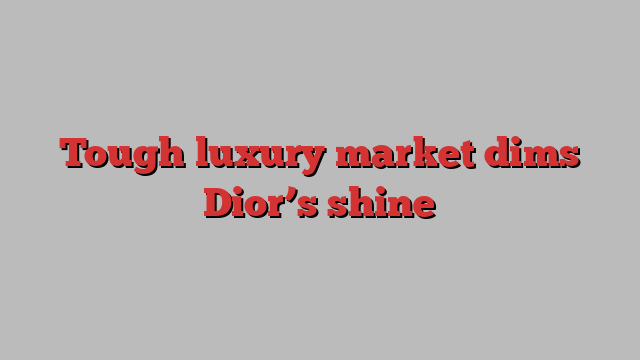
At one of Shanghai’s most exclusive malls, a Dior store is spread across four floors and includes special tea rooms for premium shoppers, in a market that was once associated with rapid growth for luxury brands.
But on Thursday afternoon there were few customers despite it being launch day of the French company’s new spring collection in China.
“You can’t compare it to before,” said one assistant. “The entire market is like this”.
Chinese consumers helped drive an unprecedented boom in the global luxury sector in recent years but a deepening slowdown in the crucial market is now taking its toll on some of the sector’s biggest names.
Shares across the industry dropped this week after Dior owner LVMH, the world’s biggest luxury group, reported a fall in third-quarter sales on the back of weakening Chinese demand.
Sales in LVMH’s core fashion and leather goods division — the industry bellwether that houses top brands including Louis Vuitton and Dior — fell 5 per cent, the first contraction since the start of the Covid-19 pandemic in 2020 and worse than consensus expectations.
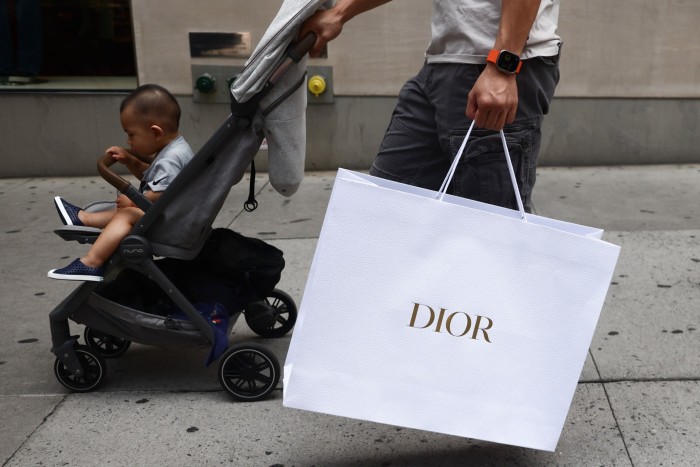
“If you look at growth rates from 2021 to 2023 . . . eventually something has to give. It’s not sustainable. So you have this very, very fast normalisation, and I think the problem at this time is Dior,” said Flavio Cereda, luxury investor at GAM.
“Louis Vuitton is holding up OK — not great, but it’s an amazing brand. The rich, the poor — they’ve managed to make products for everyone. But Dior has now become more difficult.”
That presents a challenge for Delphine Arnault — the eldest child of LVMH’s billionaire owner and chief executive Bernard Arnault — who took over as Dior CEO at the start of last year following a period under her predecessor Pietro Beccari when the brand’s sales grew fourfold to about €10bn, according to HSBC estimates.
LVMH does not release financial data on the performance of individual brands. But chief financial officer Jean-Jacques Guiony said Louis Vuitton’s sales in the quarter had been “a little bit above the average” in the fashion and leather goods division, “while Dior is a little bit below”.
People familiar with the performance say Louis Vuitton sales were down by low single digits, while Dior’s decline was in the low double digits. Smaller Fendi, which had an estimated €2.5bn in sales last year, is also facing a drop in revenues, the people said.
“While Louis Vuitton and Dior have tended to trend similarly previously, we see quite a dichotomy now,” analysts at HSBC wrote, adding that “the success of [smaller brands] Loro Piana, Loewe and Rimowa will have been negated by declines in other parts of that portfolio.”
LVMH and Dior declined to comment.
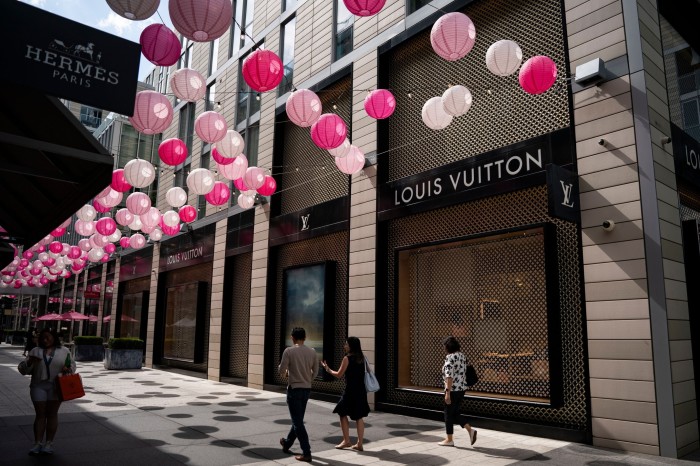
The world’s biggest luxury group with a market value of €312bn, LVMH owns almost 100 brands ranging from hotel chains to perfumes, but Louis Vuitton — a megabrand with roughly €22bn in annual sales — and Dior are the two biggest contributors to profits. Together they accounted for about 65 per cent of group earnings before interest and tax last year, according to HSBC.
LVMH is not alone in facing tougher times as the industry adjusts after years of record growth, but is faring better than some peers. In central Shanghai, Burberry and Gucci stores were also quiet at the same downtown shopping complex.
Another Dior store in the city’s financial district had more customers for the new collection, although an assistant at one of the company’s make-up stalls elsewhere in the city said footfall was down 20 per cent and that they had reached out to repeat customers to drum up business.
Shares in LVMH rival Kering are down more than 40 per cent this year after a series of profit warnings, a rarity in the sector. Sales at its flagship brand Gucci are expected to have fallen 23 per cent year-on-year when the group reports third-quarter revenues next week, according to Barclays.
But within LVMH, Dior now faces the challenge of forging a path forward under a new chief executive after a period of turbocharged growth.
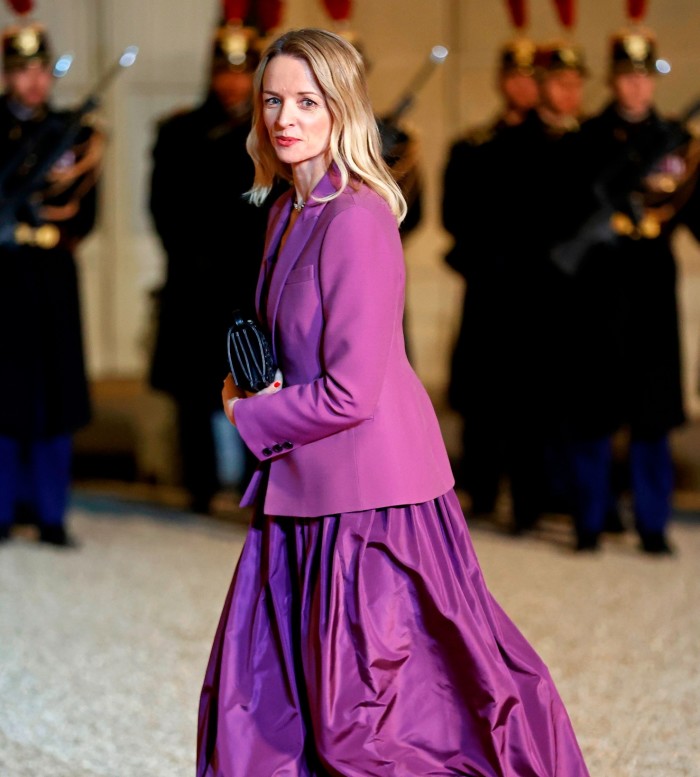
“There is some resetting happening,” said one luxury financier, adding that Delphine Arnault’s “energy is not the same” as Beccari’s, and “she’s coming into something that is perhaps a bit stressed after being milked for growth”.
Beccari, now chief executive at Vuitton, transformed Dior by moving it into new categories and gaining market share across women’s and men’s fashion, leather goods, jewellery and homeware.
During his time at Dior, he was “all about volume, being aggressive, and is very very good at that”, said Cereda at GAM. “But exceptionally strong growth also came from excessive price increases as we saw at Chanel.”
Average prices for luxury goods tracked by HSBC have risen 50 per cent since 2019. Dior has raised them the most, according to Bernstein analysis, pushing up like-for-like price tags on “evergreen” products by more than 60 per cent between 2020 and 2023.
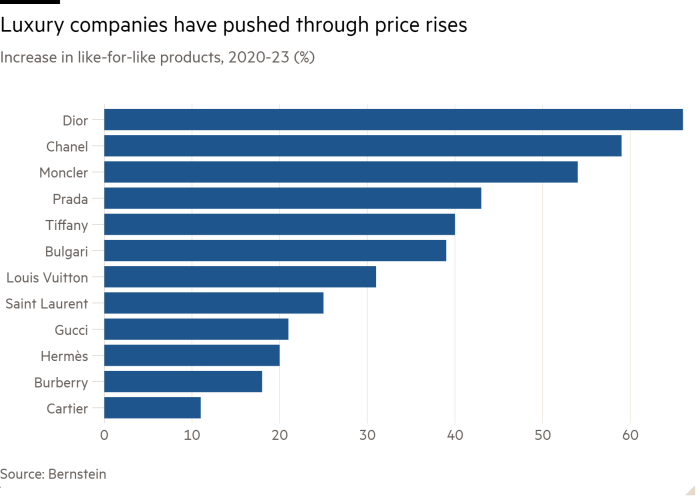
“At some point in the consumer’s mind, the absolute numbers just don’t make sense,” said the luxury financier. For the industry as a whole “you can no longer just grow through price” — particularly at top brands such as Dior and Vuitton that are now so big that they need to look beyond the ultra-wealthy for sales.
Delphine Arnault has been focused on “long-term desirability”, a person close to her said, investing in the Dior brand through big destination runway shows — such as a recent one in Scotland — and dressing stars from Céline Dion to Lady Gaga at the Paris Olympics opening ceremony.
Industry players say a recent investigation by Italian authorities into poor labour conditions at factories working as subcontractors for brands including Dior and Armani has had little impact on customers, but that Dior faces broader questions about the quality of some items particularly in light of the scale of price increases.
“We’re already at a price point where affluent customers have problems with spending power, and there is an issue with the price point at Dior,” said another person close to the group.
Analysts at research firm Third Bridge also note that Dior — where Maria Grazia Chiuri has been creative director since 2016 — has not launched a new blockbuster bag since the “book tote” hit the market more than three years ago.
“Handbags are the cornerstone of luxury brands, as they are often the most prominent and lucrative category,” said Third Bridge analyst Yanmei Tang. “The lack of relevance with customers in the handbag segment appears to be part of a broader issue affecting Dior’s product line-up.”
A person close to Delphine Arnault said recent launches such as the Toujours bag released six months ago were performing well. Under her leadership the brand has also increased the number of bags it includes in Chiuri’s runway shows to build out the key product offering, with a focus on appealing to the brand’s highest-end clientele. “This is where most of Dior’s growth is coming from,” the person said.
For luxury’s biggest brands, sustaining momentum is a challenge once a certain scale has been reached.
After €10bn in sales, “you need an exceptional storyline, heritage and product for a lot of different customers while managing the dilution of exclusivity”, said Cereda. “Walking around any Dior megastore quickly flags what the challenges are today.”